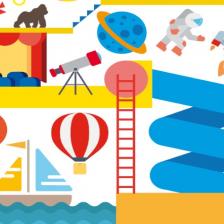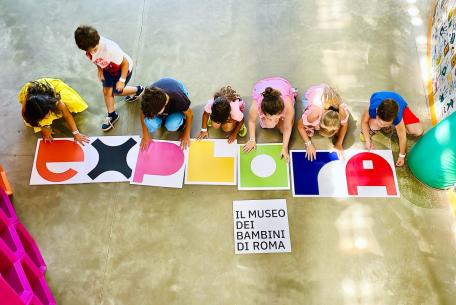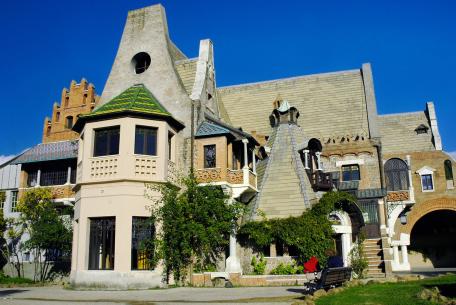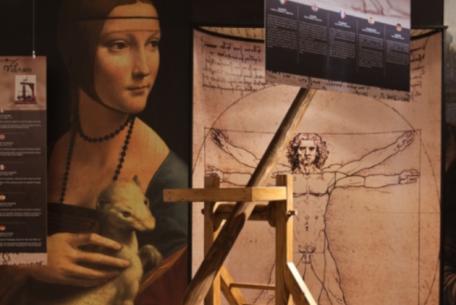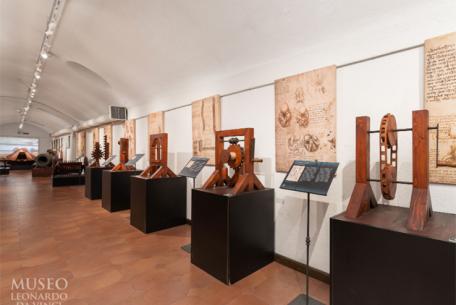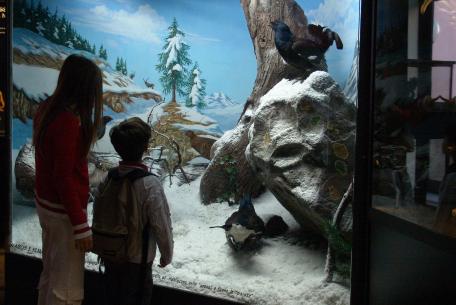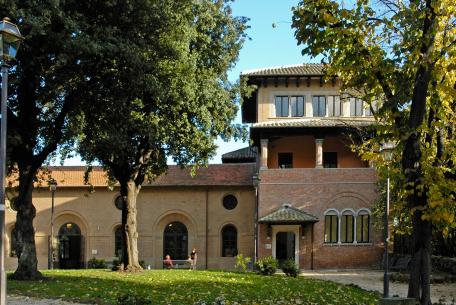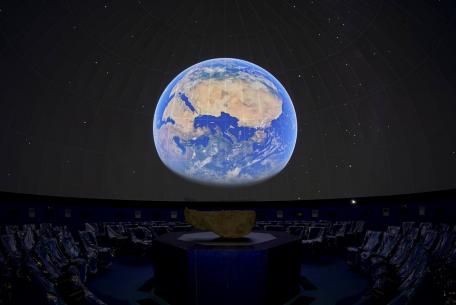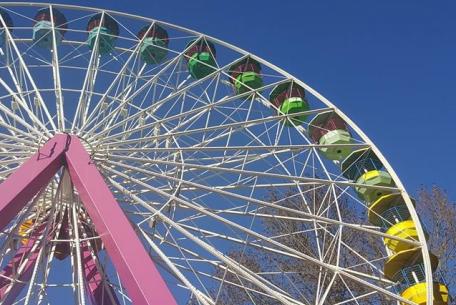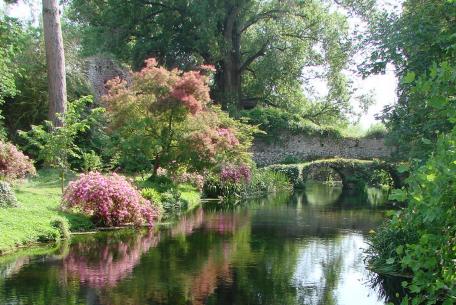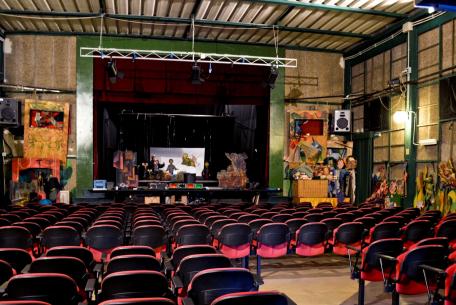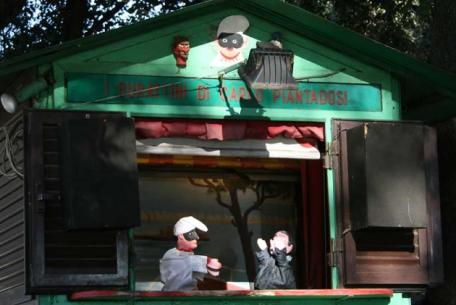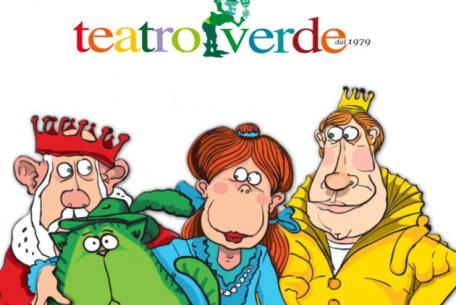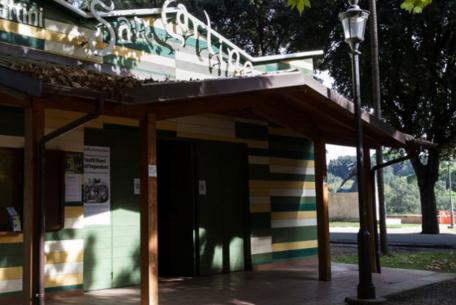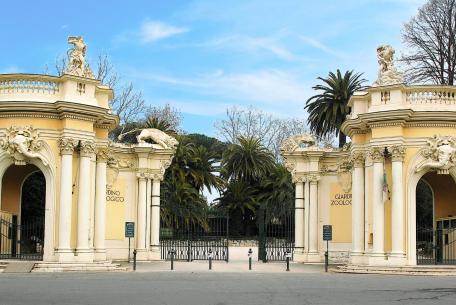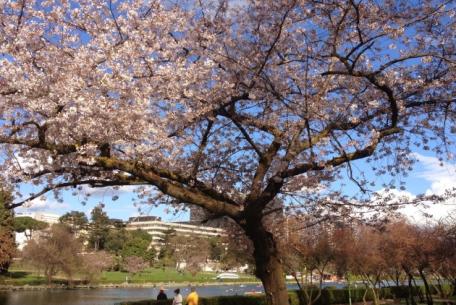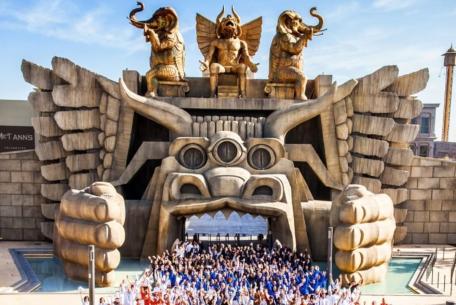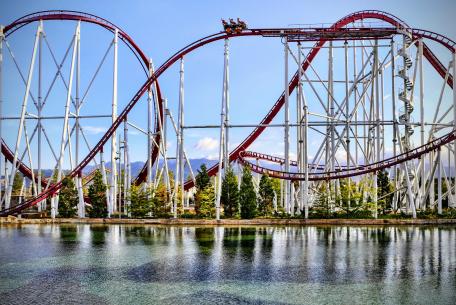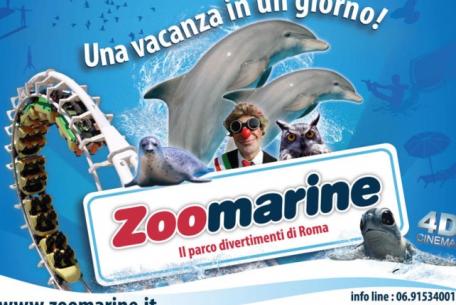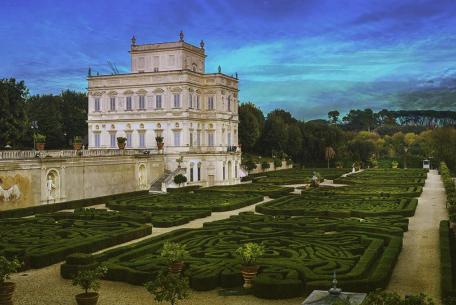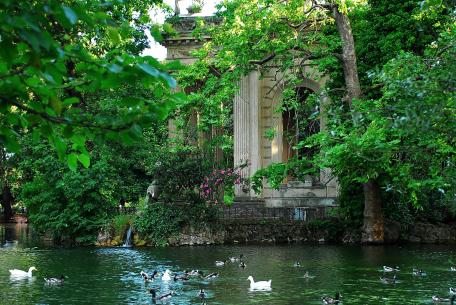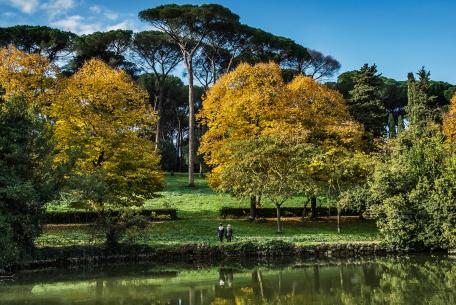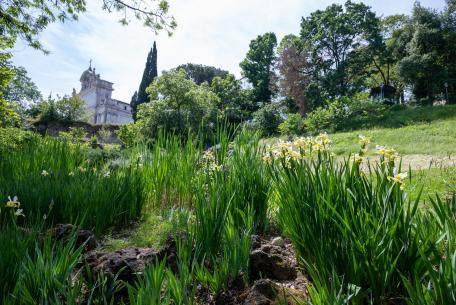
Rome is a wonderful city that enchants both young and old, but sometimes it is difficult to meet the individual needs of each family member while on holiday.
The following itineraries present the places and activities that are best suited to curious little tourists by theme, and which can stimulate the awareness and participation of children and their families.
1 Museums and attractions
Museums
Explora - museo dei bambini (Children’s Museum)
Via Flaminia 80/86
Explora, a permanent structure for children aged 0 to 12, is located just a stone’s throw from Piazza del Popolo, in the area of the former Atac depot, whose redevelopment has allowed the creation of a space without architectural barriers, built with recycled materials.
It is based on the model of international educational museums for children in which the they can observe, touch and discover independently through play and socializing. There are interactive installations such as the supermarket, fire truck, vegetable garden, fountain, reuse, game of the wind, Small Explorers area, the area for reflecting and studying Equal Opportunities, Economy, emotions, environmental protection and much more. It proposes periodic activities and special events and has a bookshop, a restaurant, a cafeteria, and an equipped green area.
Casina delle Civette - Villa Torlonia
Via Nomentana 70
As the result of various architectural interventions carried out between 1840 and 1913, the building took on its current appearance in the 1920s thanks to the architect Vincenzo Fasolo, working on behalf of Prince Giovanni Torlonia. Thanks to the contribution of well-known artists of the time such as Cambellotti, Paschetto, Bottazzi and Grassi, the Casina was enriched with floor mosaics, stuccoes, majolica tiles, wall paintings and especially Liberty-style stained glass, with various owl-related decorations which gave the building its name (“civetta” in Italian means owl). A fabulous place that can win over both adults and children.
Leonardo da Vinci Experience
Via della Conciliazione 19
An engaging multimedia itinerary of over 500 square metres hosts a collection of 46 new machines and 22 faithful reproductions, in original size, of Leonardo’s most famous paintings, including the Mona Lisa and the Last Supper. A fascinating journey among educational paintings, mechanics, projections, holograms and audio, divided into five thematic rooms which will thrill visitors of all ages.
Museo Leonardo da Vinci - Il genio di Leonardo
Piazza del Popolo 12/a
The exhibition aims to document the genius of Leonardo da Vinci, inventor and engineer, through the exhibition of models that interpret his original projects. The machines on display are from the most diverse sectors, ranging from flying machines to war machines, from mechanical devices to civil engineering; the itinerary is enriched with reproductions of his drawings and projects, as well as various didactic panels and multi-medial stations for in-depth study.
Vigamus - The Video Game Museum of Rome
Via Sabotino, 4
The first Italian museum dedicated to videogames with collections of games, consoles, vintage cars and unique pieces, temporary exhibitions on some of the most famous games and over 30 stations to play the best videogames of today and the past. In the VR Room, visitors can experience the thrill of wearing the viewer and discover what it means to immerse themselves in the virtual world of their favourite video game and observe it from the eyes of the protagonist.
Stadio di Domiziano
Via di Tor Sangugina 3
The archaeological area of the Stadium of Domitian is located about 4.5 metres below the current level of Piazza Navona and houses the remains of the large masonry stadium of ancient times. The space was recently opened to the public and offers thematic exhibitions on the location’s history
and ancient Roman sporting activities, shows and traditions, as well as more detailed activities, visits and educational workshops for both the young and old.
Memoria Giocosa Bibliomuseo - Museo storico didattico di giochi, giocattoli e memorabilia del '900
Via Marco V. Coronelli, 26
The museum was born from the collection of the Viennese Fritz Billig, with almost three thousand tin toys built between the 1920s and 1960s. Open on Fridays and Saturdays, it also offers a thematic library service on the history of toys and street games, pop-up books on fairy tales and tin toys of comic characters. Also on display is a large railway landscape with stations, overpasses, level crossings, shelters, houses and bridges on which four trains run on electric rails.
Scientific museums
Museo Civico di Zoologia
Via Ulisse Aldrovandi, 18
The Civic Museum of Zoology was founded in 1932 and has an impressive 5 million preserved specimens, ranging from mollusc shells of a few millimetres in size up to a 16 metre-long whale. The museum’s new exhibition path is based on biodiversity in the animal world. The variously themed rooms, which also include multimedia and multi- sensory tools, allow visitors to learn about different animal forms and understand their origin and adaptations to multiple types of environments.
Museo Nazionale Preistorico Etnografico ‘Luigi Pigorini’
Piazza Guglielmo Marconi 14
Founded by the paleoethnologist Luigi Pigorini, the Museum was inaugurated in 1876 in the building of the Collegio Romano, and then transferred to its current EUR location in the seventies. The museum is organised into two sectors, with one dedicated to Prehistory and the other to Ethnography; the halls are equipped with didactic and plastic supports, reconstructions, graphic devices and multimedia and digital tools that provide rigorous scientific information while also managing to involve and intrigue both child and adult visitors.
Museo del Pleistocene – Casal de’Pazzi
Viale Egidio Galbani, 6
The history of the Museum begins with the discovery of an elephant tusk in 1981 during the urbanisation of the Rebibbia area, which set off an archaeological investigation. More than 2,000 animal fossils have been found in the ancient redevelopment of the river basin, belonging to species which are unimaginable today in the Roman countryside - including the elephant, the hippopotamus and the rhinoceros - as well as 1,500 limestone artifacts that bear witness to the contemporary presence of humans.
Technotown – Ludoteca tecnologico scientifica
Via Lazzaro Spallanzani 1
A unique and avant-garde centre in the panorama of Italian edutainment projects, since 2006 it has been housed inside the Villino Medioevale, a characteristic early 20th-century architecture building. The young guests learn to interact with sophisticated technologies through games and experiences with highly educational content, including three-dimensional projections, group games, and virtual and interactive realities. It offers exhibitions and workshops for girls and boys aged 12 and over, creative factories and numerous activities dedicated to science, technology, ingenuity, art and mathematics, including electronic music, photography, 3D printing, cyanotype and more. Among the many new features, it hosts the first Podcast House in the world, where you can immerse yourself in the universe of digital audio content.
Planetarium and Astronomy Museum
Piazza Giovanni Agnelli, 10
Housed in the Museum of Roman Civilization, the Planetarium welcomes you with new cutting-edge technology, immersive experiences, appointments for all ages and the astronomical show Planetarium: return to the stars. Thanks to the new Sky Explorer software, it is possible to "enter" the sky and navigate in any direction of space and time, admiring the Earth, the Moon, Mars and the brightest stars, including galaxies and nebulae.
2 Theatres and libraries
Teatro Mongiovino degli Accettella
Via Giovanni Genocchi 15
The Mongiovino Theatre of Accettella has been operating without interruption for 70 years, promoting shows aimed exclusively at children and teenagers which use puppet theatre and innovative drama based on myths, legends and popular fairy tales.
Puppet Theater on the Janiculum Hill
Passeggiata del Gianicolo
A traditional outdoor puppet show is held near the Janiculum’s panoramic terrace only at weekends, with variable hours and lasting about half an hour. Puppets can also be purchased there.
Teatro Verde
C.ne Gianicolense 10
Verde Theatre is the official theatre for Rome’s children and youth; it offers over 30 shows which have been chosen and created for the very young, as well as exhibitions, shows, courses and theatrical workshops for boys and girls.
San Carlino - Teatro dei burattini
Viale dei bambini - Villa Borghese
In the splendid setting of Villa Borghese, the San Carlino puppet theatre is located indoors; it offers entertaining shows suitable for the whole family every weekend and during the holidays.
La Biblioteca Centrale Ragazzi
Via San Paolo alla Regola 15-18
The Institution of Libraries Cultural Centres of Roma includes over 40 facilities, each of which houses a section dedicated to the little ones and where promotional activities are organised for reading. In particular, we’d like to highlight the Biblioteca Centrale Ragazzi (Central Children’s Library) specialised in young adult and children’s literature in Italian and foreign languages, with reading rooms and books on loan. The libraries of Rome host the project “Nati per leggere” (Born to read) based on meetings which consist of time for parents to read aloud to their children (from 0 to 3 years), choosing pieces from childhood literature, with the support of specialised operators. The schedule for events and meetings can be consulted online.
Teatro Ragazzi at Teatro di Roma
Various places
The program of shows dedicated to children and young spectators of the Teatro Torlonia, Teatro India and Teatro Argentina. It ranges from classics to fairy tales, up to contemporary creations and reinterpretations.
Teatro Ragazzi at Teatri in Comune
Various places
The rich theatre program for children and new generations of the network of entertainment spaces of Roma Capitale, consisting of the Teatro del Lido di Ostia, Teatro Biblioteca Quarticciolo, Teatro Tor Bella Monaca and Teatro Villa Pamphilj.
3 Theme parks and outdoor activities
Outdoor activities
Bioparco
Piazzale del giardino zoologico 1
Rome’s Zoo is located inside the grounds of Villa Borghese, and houses more than 1,000 animals of over 200 different species. The zoo can be enjoyed in many different ways: on foot or while riding a small train, with a choice between paths for seeing animals or exploring the zoo’s more botanical aspect, and can be followed with or without guides and teaching assistants. Bioparco also organises courses, summer camps, and on request, special events for parties and birthdays.
Parco Centrale del Lago – Laghetto dell’E.U.R. (Central Lake Park - EUR district lake)
Passeggiata del Giappone
The lake is part of the larger Central Park of EUR, designed during the Fascist era and built in the 60s, which houses a very rich quantity and variety of flora and fauna. In particular there are pines, palm trees, cheesewood, cedars of Lebanon, hedges, holm oaks, bald cypresses and cherry laurels, in addition to the magnificent cherry trees of Japan which were donated by the city of Tokyo. There are numerous fish species in the lake even if fishing is not allowed, but certain sporting activities can be enjoyed, for example rowing.
Butterfly Eden
Largo Cristina di Svezia, 24
The paradise of tropical butterflies in the centre of Rome: in the splendid gardens of the Botanical Garden of Rome, a modern and luminous pavilion is where tropical butterflies and moths with incredible liveries live and reproduce in freedom. The Butterfly Eden is open all year round with ever-changing natural elements and settings, created by combining specific species of butterflies with the colours and shapes of the leaves and flowers of the indoor tropical garden to always live new extraordinary thematic experiences.
Theme parks
The studios of Cinecittà
Via Tuscolana 1055
The historical cinematographic studios known as Cinecittà are just a few kilometres from the historic centre of Rome; they were built in the 30s and are still used for the production of films, video clips, series and television programs. Visitors will be able to retrace the history of the “Hollywood on the Tiber” thanks to the museum tour and the guided tour of the external sets. On Saturday and Sunday younger visitors can discover the secrets of cinema through the thematic workshops offered by Cinebimbicittà.
Luneur Park - Giardino delle meraviglie
Via delle 3 fontane 100
The first real Luna Park in Italy. It was built in 1953 and made permanent on the occasion of the XVII Olympiad in 1960, hosting millions of visitors. After a period of decline, Luneur Park has come to flourish again thanks to renovations in its offer and style: surrounded by greenery, it hosts rides and attractions designed for children up to 12 years old and offers fun activities and educational itineraries dedicated to the whole family.
E.U.R. Park Adventure
Piazza Pakistan
In the shade of the pinewood in the EUR district, there is a large equipped area where adults and children have access to various routes to climb safely with the help of specialised personnel. There is also a play area for younger children as well as spaces for volleyball, table tennis, bocce ball, archery and a refreshment point.
Cinecittà World
Via di Castel Romano 200
In the area of Castel Romano where the De Laurentiis studios were built in the 60s, today the large theme park is able to transport visitors big and small into the imaginary world of cinema. In a setting characterised by scenes of famous films, reconstructed with various elements, there are rides and attractions as well as projection rooms, shops and restaurants and a naturalistic area to spend a pleasant day as a family.
Rainbow Magic Land
Via della Pace, Loc. Pascolaro, Valmontone
The park offers several attractions and a full calendar of events for all tastes and all ages: from musicals to theatre performances, and from water circus shows to magic shows. The park also offers several films in its 4D cinema and theatrical performances throughout the year, in addition to trains, roller coasters and exciting paths to discover.
Zoomarine
Via Zara, Torvaianica (Pomezia)
Zoomarine is an amusement park about 20 km from Rome where visitors can get up close to aquatic animals such as dolphins, seals and sea lions, as well as tropical birds and birds of prey, and enjoy many different activities. The area includes a water park with water slides and roller coasters as well as a swimming pool with a relaxation area and refreshment area.
Acqua Felix
Via Terme di Traiano, Località Casale Altavilla, Civitavecchia Nord
Connected to Rome by the A2 motorway, the park covers 80,000 square metres and includes several pools, 2 km of slides and several spaces with umbrellas and sunbeds in the solarium area. Completely lacking any architectural barriers and surrounded by greenery, Acqua Felix welcomes visitors of all ages all year round.
Historic villas
Villa Doria Pamphilj
The largest Roman historic villa is comprised of several buildings including the eighteenth-century Palazzina Corsini, which houses the Casa dei Teatri and a library, and the Casino del Bel Respiro, the work of Algardi, as well as several routes for walking or cycling.
Entrances: Via Aurelia Antica, Via Leone XIII, Via della Nocetta, Via Vitellia, Via di Porta S. Pancrazio.
Villa Borghese
Located in the heart of the city, Villa Borghese offers tourists of all ages the chance to immerse themselves in greenery with a variety of activities. The sixteenth-century Casina di Raffaello is a playroom that offers workshops and activities for children and youth.
Entrances: Piazzale S. Paolo of Brazil, Piazzale Flaminio, Via di Porta Pinciana, Via Raimondi, Via di Valle Giulia.
Villa Ada Savoia
The park features century-old trees and an artificial lake, and has an equipped playground near the Via Salaria entrance, in addition to several paths for discovering the history of this important place.
Entrances: Via Salaria, Via di Ponte Salario, Via di Monte Antenna, Via Panama.
Orto Botanico
Largo Cristina di Svezia 24
The botanical garden of Rome is one of the largest in Italy, with its twelve hectares of park and about 2,000 square metres of greenhouses. Its collections are of particular interest not only for scientific importance but also, and above all, for its cultivation methods and the scenographic reconstruction of its environments, which help visitors in the difficult task of picturing the species in their areas of origin.
Parks and attractions outside Rome
Sacro bosco di Bomarzo
(Bomarzo -VT)
Also known as Parco dei Mostri (Park of Monsters) or Villa delle Meraviglie (Villa of Wonders), it was built in the mid-sixteenth century and is a large green space populated by figures and structures in stone.
Parco dei Tarocchi (Tarot Park)
(Pescia Fiorentina – GR)
An outdoor art park inspired by the symbolic figures of the tarots, created by the French-American artist Niki de Saint Phalle.
Giardino di Ninfa
(Cisterna di Latina – LT)
A surprising English garden that hosts more than 1,300 species of plants. Seasonal openings with guided tours.
Giardino di Daniel Spoerri
(Seggiano – GR)
A large park located at the slopes of Monte Amiata houses the works of Daniel Spoerri and other artists to discover during a pleasant walk suitable for the whole family.
 Condividi
Condividi












































